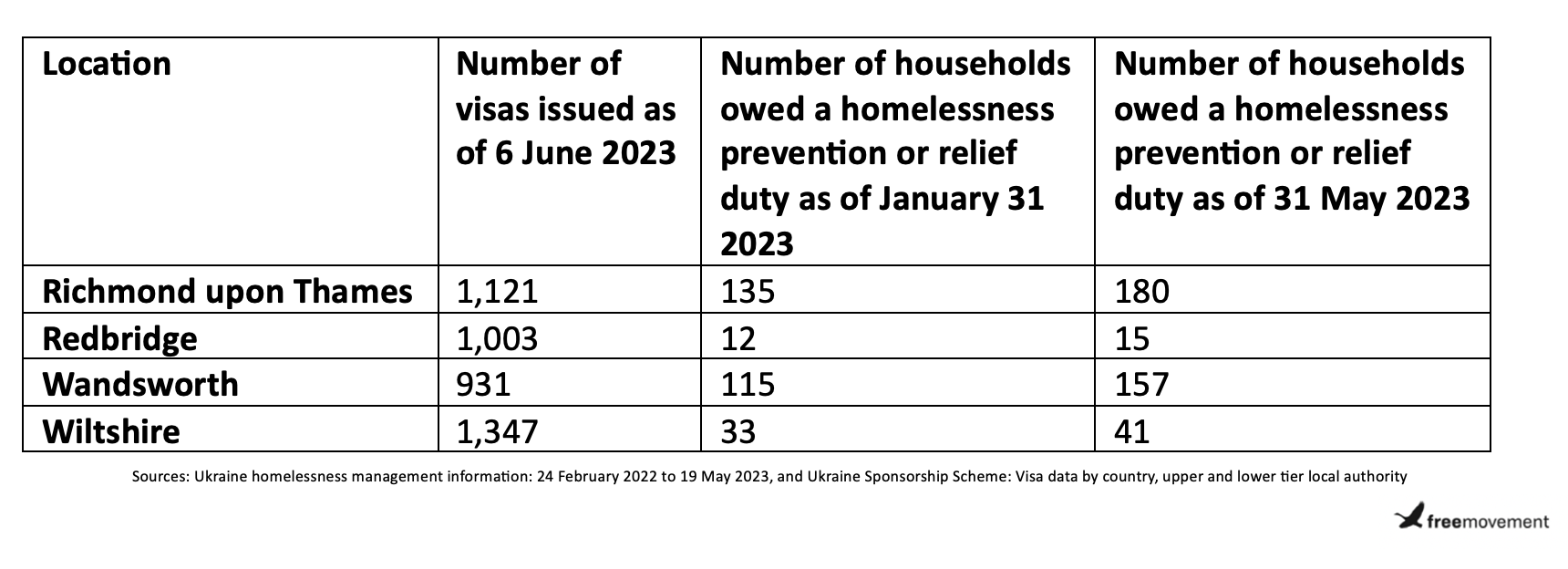- BY Josie Laidman

Data shows Ukrainians in the UK continue to face homelessness crisis
THANKS FOR READING
Older content is locked

A great deal of time and effort goes into producing the information on Free Movement, become a member of Free Movement to get unlimited access to all articles, and much, much more
TAKE FREE MOVEMENT FURTHER
By becoming a member of Free Movement, you not only support the hard-work that goes into maintaining the website, but get access to premium features;
- Single login for personal use
- FREE downloads of Free Movement ebooks
- Access to all Free Movement blog content
- Access to all our online training materials
- Access to our busy forums
- Downloadable CPD certificates
The Ukraine Scheme homelessness statistics released each month provide an update on the long-term consequences of additional schemes for people with Ukraine Scheme visas. Monitoring of progress through regular data publication (even if incomplete) highlights where the government and local councils are doing well, and where they are not. You can read more about the Ukraine Scheme here.
Local council homelessness prevention and relief duty
Local authorities have a duty to act to prevent homelessness. They may do so through any activity aimed at preventing people from becoming homeless, including providing resources and support to help people secure their own accommodation. This duty lasts for up to 56 days but it may be extended if the local authority is continuing its efforts to prevent homelessness.
Those found to be homeless at the end of a prevention duty are consequently owed a relief duty, helping them to find housing for at least six months.
The ongoing issue of homelessness
Surveys, including by local councils and government bodies, on homelessness and the risk of homelessness for Ukrainian’s arriving in the UK have been ongoing since last year but whether local councils have the willingness, capacity and budget to take action is another question. Throughout the autumn of 2022, we saw a number of charities and organisations scale back their support, whilst the government’s plea for more sponsors for the Homes for Ukraine Scheme to come forward had little success. You can read more about these events, as well as why Ukrainians under this scheme are particularly at risk of homelessness here.
Between 3 June and 26 August 2022, there was a 137% increase in the number of homeless Ukrainian households in the UK, from 660 to 1565. Recent news provides examples of where the issue is ongoing, such as this article suggesting that more than 300 Ukrainian households have made homelessness applications in the East Midlands area as of April 2023.
The total number of Ukrainian households that have been recorded by local authorities and submitted to the Home Office as owed a prevention or relief duty at the end of May 2023 is 5995. In some places, there are just a few, in others, there are over 100 households owed a duty. For example, 114 in South Oxfordshire, 115 in Shropshire, 140 in Buckinghamshire, 157 in Wandsworth, and 180 in Richmond upon Thames.
But it’s not just a case of the more visas granted for individuals arriving in (or remaining in) a particular local council the more households are currently owed a homelessness duty. Taking a few random examples of local councils that have received high numbers of Ukraine sponsorship scheme visa holders, we can see that some have managed to keep the numbers of homeless or potential homeless households low, whilst others have not.

Whilst the table above contains a random selection of local councils with a high number of visas issued since the scheme opened last year, there is no data on how many individuals have moved on from the UK since obtaining their visa.
What we do know is that as of 29 May 2023 there have been 175,800 people arriving in the UK on Ukraine scheme visas. Of these, around 120,000 were on the Ukraine sponsorship scheme. As of 6 June 2023, there have also been 26,300 permissions granted to extend stay in the UK. The numbers of visa applicants, grants and arrivals peaked in March and April 2022. One year later, these are slowly levelling out.

Transparent data
The data gathered here is by way of voluntary submission and 101 councils did not submit any data at this time. That means there was a data submission rate of 67.3%. The data is not robust and is part of an ongoing transparency report into the scheme.
Transparency in this way is useful and something that should perhaps be mirrored in other visa schemes. It helpfully contributes to showing how well the scheme has worked and how many local councils continue to work hard to offer long-term social housing and support to individuals in need who remain in the UK more long-term. Just yesterday, for example, Thanet council announced plans to buy nine homes for Ukrainian and Afghan refugee families. They were given funding as part of a national £500 million scheme offered to 182 local authorities deemed to have the greatest need, in order to purchase properties in their area to accommodate Ukrainian and Afghan refugee households for an initial period of 3 years.
Overall, the Ukraine visa scheme has been one of the government’s most successful individual schemes to date. But it is not free from faults. Now that the initial rush of the scheme has slowed, what is clear from both the participation in the voluntary data collection and the data collected is that some local authorities are offering far more long-term social housing than others, presumably down to availability, but maybe attitudes as well.
